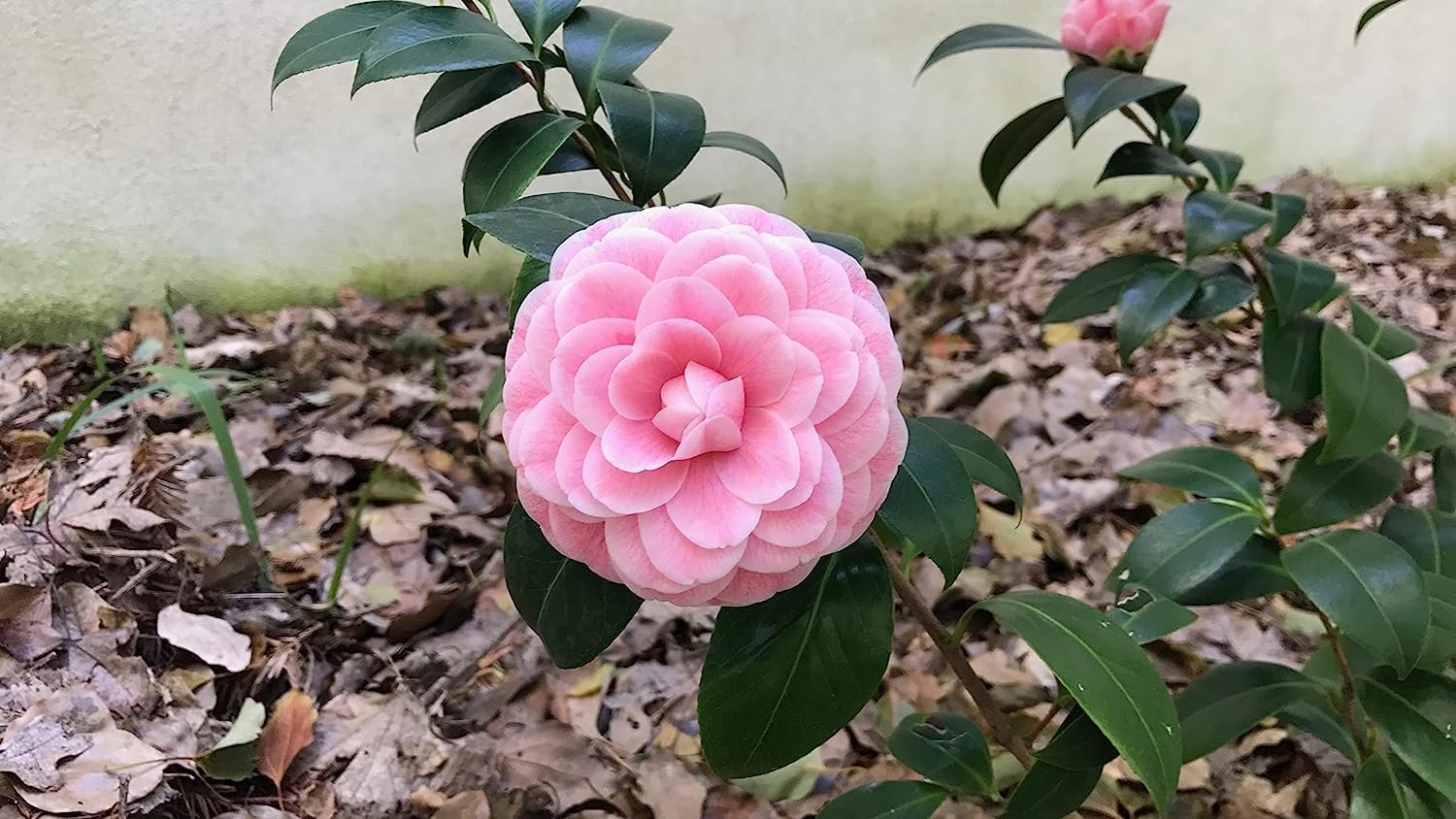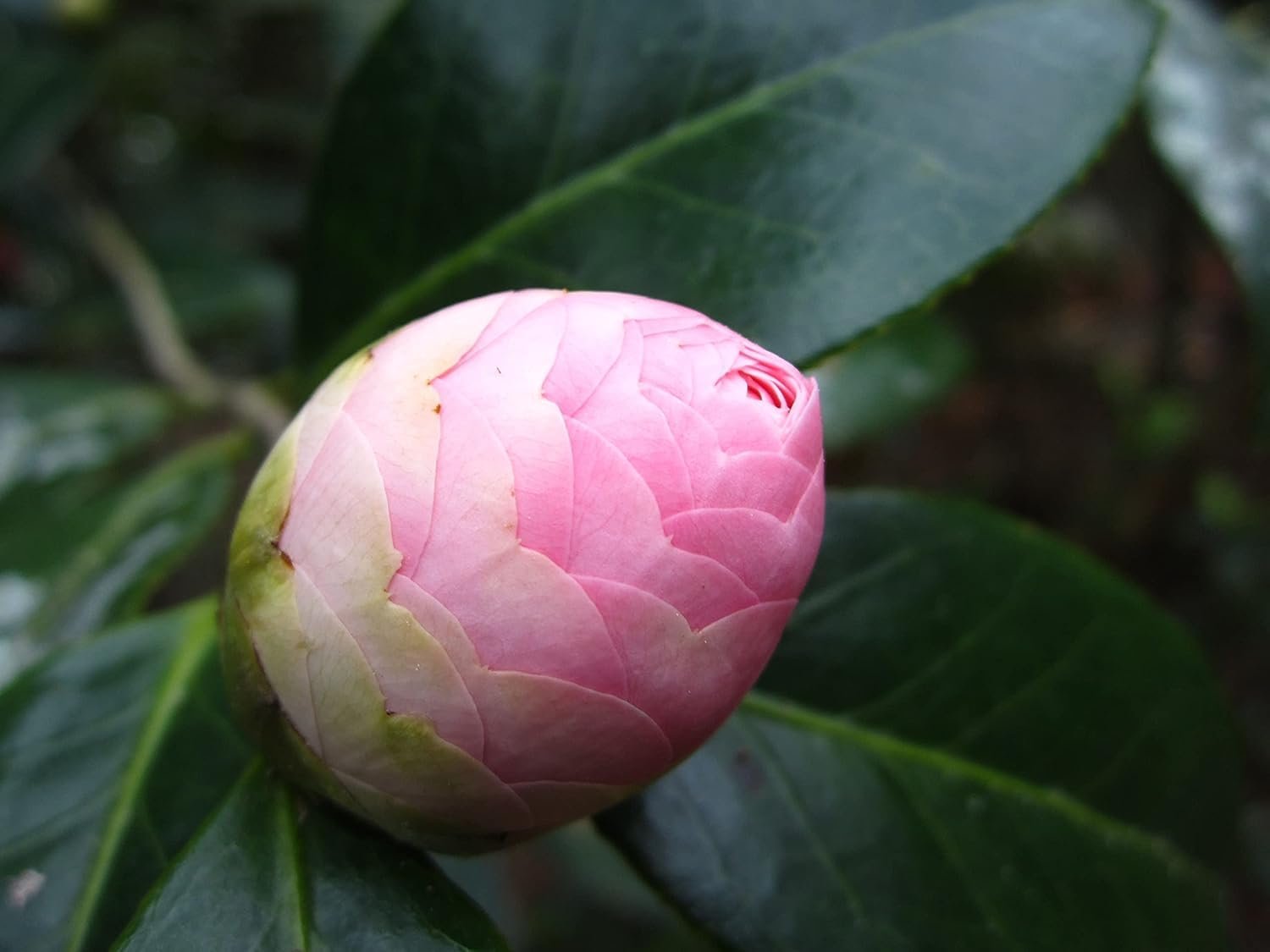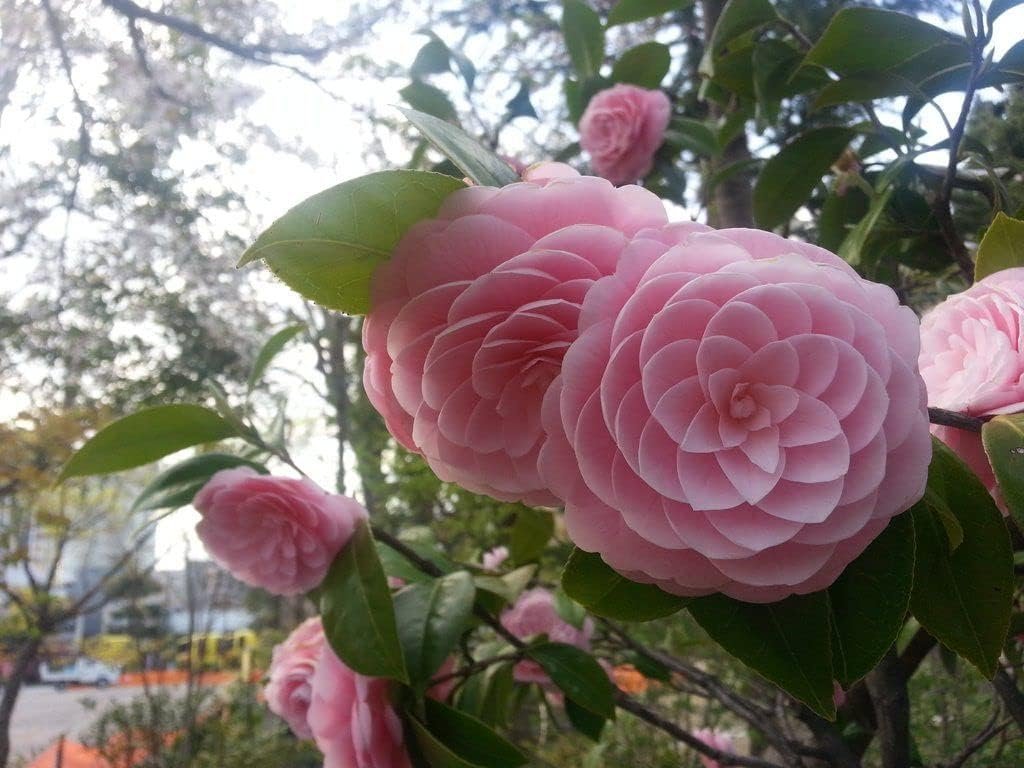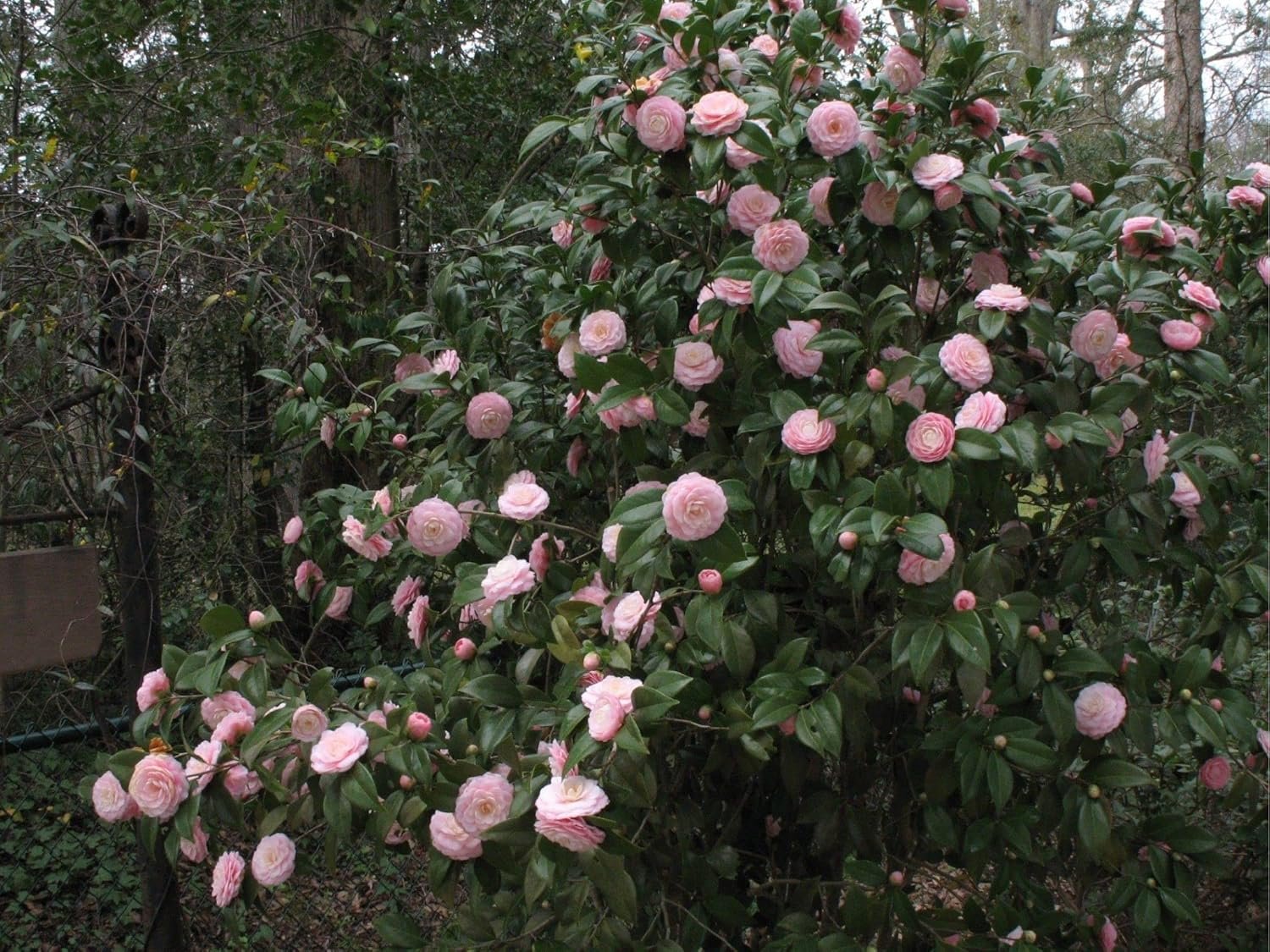Price: ₹799 - ₹355.00
(as of Nov 22, 2024 10:26:06 UTC – Details)
Product Description
Camellias Growing the Pink Perfection Camellia is a rewarding experience that can be achieved with care and attention


Follow these guidelines to ensure optimal growth and abundant blooms
Camellia Flower: Physical Description
The Camellia flower is known for its large, attractive appearance, boasting several notable characteristics:
Shape: This typically cup-shaped bloom varies in size, its diameter ranging between 2 and 5 inches.
Petals: They’re soft, velvety to the touch, and may present as either smooth or with a gentle ruffle. The petals feature a spectrum of hues such as white, pink, red, yellow, and rose.
Stamens: Camellias have stamens that serve as the male reproductive parts and are often brightly coloured in shades of yellow or red.
Leaves: The leaves of the Camellia are a deep, glossy green with an elliptical shape. These evergreen leaves persist throughout the year, never shedding.
Size: While the Camellia plant can reach a height of up to 20 feet, numerous dwarf varieties exist that are well-suited for smaller spaces.
Bloom Time: Camellias offer a varied blooming schedule, with different types of flowering from late fall to early spring.
Fragrance: The scent of a Camellia can vary; some exude a sweet, mild aroma, while others do not have any fragrance at all.
Camellia Flower: Quick Facts
– Name: Camellia
– Kingdom: Plantae
– Family: Theaceae
– Genus: Camellia
– Origin: Native to Eastern and Southern Asia
– Typical Colors: Includes red, pink, white, and yellow
– Blooming Season: From late winter to early spring
– Flower Size: Ranges from 1.5 to 5 inches in diameter
– Popular Varieties: Camellia japonica, Camellia sasanqua, Camellia reticulata
– Represents: Love, affection, admiration, and gratitude
– Primary Uses: Mainly as a decorative plant and for making tea (Camellia sinensis)
– Fascinating Detail: Camellia sinensis is the source of both black and green tea.








Centuries of Love and Admiration
The Pink Perfection Camellia is not just a plant; it’s a part of history and tradition. This heirloom camellia variety has been cherished and loved for centuries, gracing gardens with its beauty and becoming a symbol of elegance and refinement. By choosing the Pink Perfection Camellia, you’re embracing a legacy of horticultural appreciation and adding a touch of timeless charm to your own garden. Join the ranks of those who have admired and cultivated this beloved camellia variety throughout the years.
A Versatile and Timeless Plant
The Pink Perfection Camellia Japonica is a versatile plant that can be enjoyed in various settings. Its classic beauty and timeless appeal make it an excellent choice as a specimen plant or accent plant in gardens. Create a focal point by placing it in a prominent spot, where its stunning flowers can take center stage. Alternatively, incorporate it into woodland gardens or use it as a foundation planting to enhance the overall aesthetics of your landscape. No matter where it’s planted, the Pink Perfection Camellia will effortlessly captivate all who behold it.
Stunning Beauty in Pale Pink
Experience the allure of Pink Perfection Camellia Japonica, a live plant that enchants with stunning beauty. Delicate, fully double flowers in a captivating shade of pale pink. This a true Southern statement, embodying elegance and grace. Overlapping petals add depth and texture, bringing sophistication to any landscape. Exquisite blooms form in summer and fall, culminating in a breathtaking display in late winter through early spring.
Evergreen Foliage for Year-Round Charm
Not only does the Pink Perfection Camellia captivate with its blooms, but its glossy deep green foliage also ensures year-round charm in your garden. Unlike deciduous plants, this camellia variety remains evergreen, providing a beautiful backdrop even during the colder months. Whether it’s a snowy winter or a sunny summer, the Pink Perfection Camellia’s lustrous leaves will remain steadfast, adding a touch of vibrancy and life to your outdoor space.
Camellia Flower: Growing Guide
To successfully cultivate Camellia flowers, one must give them attentive care. Follow these steps to grow healthy Camellias:
1. Select an ideal spot: Camellias thrive in partly to fully shaded areas and require soil that drains well with a slightly acidic pH, ideally between 5.5 and 6.5.
2. Choose a robust plant: Opt for a Camellia with vibrant green leaves and a solid root system.
3. Prepare the soil properly: Camellias need acidic, well-draining soil that’s kept moist without becoming soggy. Enhance the soil by mixing in compost or peat moss to better its texture and acidity.
4. Water consistently: Keep the soil moist, but take care to avoid waterlogging. The soil should never completely dry out.
5. Fertilize appropriately: Use an acid-based fertilizer on your Camellia in the early spring and then again in mid-summer.
6. Trim when needed: Post-blooming, prune the Camellia to maintain its shape and promote vigorous growth.
7. Ensure good airflow: Adequate air circulation around your Camellia is crucial to stave off mould and diseases.






How to grow a camellia in a pot part 1
Camellias thrive in containers, which is a suitable choice when acid-rich soil is lacking in your garden. Utilize a peat-free, soil-based mixture that is specifically formulated for ericaceous plants and select a pot with a minimum width of 30cm.
Prior to commencing, thoroughly water the camellia (preferably using rainwater) while it remains in its original container. Ensure thorough saturation of the roots and allow excess water to drain. Position your designated pot in its permanent location before transferring the camellia to avoid difficulty due to its weight.
How to grow a camellia in a pot part 2
Ensure adequate drainage by adding crocks and creating holes in the base of your pot. Use ericaceous compost to fill about two-thirds of the pot, leaving space for the plant.
Create a hollow in the compost that is large enough to accommodate the camellia’s rootball. Gently place the rootball in the pot.
Position the plant centrally, ensuring that the top of the rootball is approximately 5cm below the rim. Fill in the gaps around the roots with compost, firmly pressing down with your fingers. Water the plant thoroughly and allow excess water to drain.
Camellias are slow-growing and do not require frequent repotting. However, it is advisable to repot them in fresh compost during the spring before they become visibly root-bound.
How to care for camellias
To prevent the plant from looking unsightly, remove brown camellia flowers. Deadheading does not promote new flowers.
If possible, water camellias with rainwater. This is crucial in areas with hard water containing high calcium deposits, which can affect the soil’s acidity. If rainwater is unavailable, use tap water. Maintaining adequate watering, especially between July and September, ensures the formation of next year’s flower buds.
Unless showing signs of ill-health, camellias grown in suitable conditions do not require feeding. A feed will quickly revive plants. Avoid excessive feeding in summer to prevent bud drop. Applying good quality bark mulch in spring boosts the plant and enhances soil condition.
No need to prune camellias for blooming. Some types grow up to 5m tall. Prune for height and shape after flowering if space is limited..
Camellias, once deemed delicate, thrive. Shield buds and blooms from frost and snow with fleece. Move potted camellias to greenhouse








Camellia flower: How to care?
To maintain healthy Camellias, adhere to the following guidelines:
Select acidic, well-draining soil
Situate them where they will receive partial to full shade
Ensure consistent watering to maintain moist soil, careful to avoid waterlogging
Apply an acidic fertilizer in spring and again in mid-summer
Trim the plants after they bloom to shape them and clear away any damaged or diseased branches
Shield them from strong winds
Foster good air flow around the plants to deter fungal diseases
Given appropriate attention, Camellias will flower for many weeks, enhancing the charm of your garden.
Camellia flower: Uses
For ornamental purposes, Camellia is treasured for its vibrant and showy flowers, which vary in color from white to pink to red. People commonly grow it in gardens to enhance the aesthetic appeal.
In tea production, the Camellia sinensis plant gives us all types of tea including green, black, and oolong. The leaves are picked and processed to make the tea we drink.
In the making of oil, particularly Camellia oil, the seeds of the Camellia oleifera plant are cold-pressed. This oil is frequently used for cooking and also as a component in cosmetics.
For medicinal purposes, Camellias have been traditionally utilized to manage various health issues like digestive disorders, skin irritations, and the common cold.
Lastly, Camellias are widely incorporated in bonsai creation, the traditional practice of cultivating miniature trees.
Camellia flower: Toxicity
Camellia flowers are safe for human consumption. Nonetheless, certain Camellia species, like Camellia sinensis, have seeds and leaves that contain trace amounts of caffeine and theobromine. These substances can become toxic when ingested in high volumes. Therefore, it’s advisable to prevent pets and children from accessing any part of the Camellia plant, as eating it may lead to digestive problems.
Planting the camellia
Plant the camellia by digging a hole twice as wide as the plant’s root ball. Make the hole slightly deeper than the root ball at the center, but excavate a few inches more around the edges. This shallow center helps prevent the plant from settling too much. The deeper edges allow the roots to easily expand into the looser soil.
Position the root ball in the hole, ensuring its top sits a little above ground level. This is crucial because camellias are prone to issues if planted too deeply—keep the top 2–4 inches (5.1–10 cm) above the soil surface. Fill the remaining space with a blend of topsoil and organic material.
Firmly press the soil around the plant. Grade the soil upwards to the top of the root ball without covering it. Water the plant deeply after planting. During dry weather, water the new plant thoroughly every week until it’s firmly rooted.








Vermin and ailments. Yellow, chlorotic leaves, due to alkaline soil
Frost damage or snow can result in brown flower buds especially when followed by morning sun If you anticipate a cold spell or reside in a cold region covering your plant with fleece is recommended. If your plant is located in an east-facing area relocating it to a part of the garden that avoids morning sun could be considered
Frost damage can also inhibit the opening of flowers. Excessive sunlight in the morning can dry out developing flower buds too swiftly, causing the outer petals to dry and preventing the flowers from opening.
Camellia flower blight, known as Coborinia camelliae, causes brown patches on petals. Although it resembles frost damage, blight affects the entire flower resulting in flecks on the petals and early dropping. No chemical solution exists so it is crucial to promptly remove any affected blooms and clear away dead leaves and debris from the plants base. Dispose of them in the bin or burn them to prevent further contamination do not add them to the compost heap
Vermin and ailments. Yellow, chlorotic leaves, due to alkaline soil part 2
High soil alkalinity causes lime-induced chlorosis, resulting in yellowing leaves due to insufficient iron uptake. If your camellia is potted, repot it using fresh ericaceous compost and fertilize with ericaceous plant food. For ground-planted camellias, apply a layer of leaf mould, composted bracken, or composted pine needles, and utilize a product containing chelated or sequestered iron. Leaf scale insects cause sooty mold on leaf surfaces, sticking themselves like limpets underneath. Eliminate both insects and mold using a specialized plant-friendly soft soap solution. Check out our informative Quick Tips video featuring Kevin Smith explaining sticky camellia leaves. Flowers absence in spring may result from unfavorable previous summer growth conditions and lack of bud formation due to drought. To promote flowering, adequately water in summer, apply ericaceous fertilizer, and mulch for root moisture. Alan Titchmarsh elucidates camellia flowering issues and suggests remedies
How to propagate camellias
Camellias can be propagated using semi-ripe cuttings, hardwood cuttings, layering, and grafting. Although it’s possible to grow them from seed, this method is difficult because the seeds are hard to germinate and the plants take several years to mature. Moreover, growing from seeds doesn’t uniform offspring.
Additional Camellia Plant Maintenance
In American gardens, you primarily encounter two types of camellias: japonica and sasanqua. Sasanqua camellias are the hardier variety, better withstanding drought and disease than japonicas. Nevertheless, both species benefit from a bit of pruning to keep them looking their best. It’s important to prune them at different times. Japonicas, which blossom in early spring, should be trimmed right after their flowers wilt. In contrast, sasanquas bloom in the fall and set their flower buds in the spring, so they should be pruned early in the spring to prevent cutting off the budding flowers. A simple touch-up, which involves clipping the tips of branches, will suffice to promote a bushier growth.
Effortless To Cultivate. Camellias are shrubs or small trees that remain green all year round and can reach heights of up to 20 m (66 ft). The leaves of camellias are thick, glossy, and have serrated edges. They are alternately arranged on the plant. The flowers of camellias are typically noticeable and sizable, measuring one to 12 cm in diameter. Naturally occurring species of camellias have five to nine petals.
Costs for maintenance are low. Captivating Beauty in Every Blossom The Camellia Flower Plant, with its enchanting blossoms, is a captivating addition to any garden or floral arrangement. Known for its vibrant colors and exquisite petals, the Camellia flower is a sight to behold. From soft pastels to bold and vibrant hues, each blossom radiates elegance and grace. Whether used as a centerpiece or added to a bouquet, the Camellia flower is sure to captivate and inspire.
Camellias: Longevity & Beauty! These flowers live 500+ years, offering enduring beauty. Evergreen leaves add year-round interest, vibrant blooms during season. Perfect for heirlooms or appreciating nature’s charm, Camellias are a timeless choice.
The plant might appear dry due to travel time. is still good as it is a live plant. Pyanabi advises putting it again in the soil, adding the complimentary fertilizer in the package watering it, and observing for a week. It will regain its freshness.
After Receiving The Pyanabi Suggestion Dont Give Them Direct Sunlight Otherwise Their Leaves Might Get Burn And The Plant. Planting, Dig A Hole Twice As Wide And Deep As The Polybag Your Plant Comes In Backfill By Mixing Compost With Your Topsoil
Customers say
Customers like the plant health of the product. They mention it looks fresh and has some buds. However, some customers have reported that the leaves fall off one by one. Opinions are mixed on the condition of the plant and value for money.
AI-generated from the text of customer reviews

















 No products in the cart.
No products in the cart. 
Reviews
There are no reviews yet.